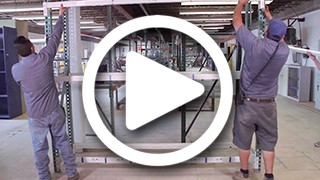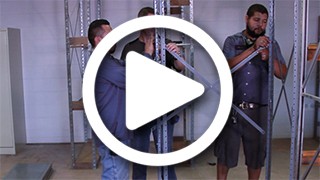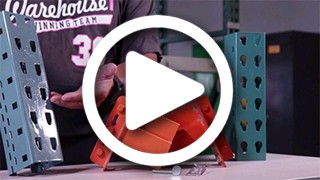Pallet Rack Safety Guide: What New Employees Need to Know
 Pallet racking systems optimize warehouse layouts and improve workplace efficiency, but they also bring some element of risk to the warehouse environment. These risks center around the heavy loads placed upon the pallet racks. If the racks are not properly constructed, maintained, or used, fallen objects or even collapses are likely, leaving anyone in the vicinity at huge risk.
Pallet racking systems optimize warehouse layouts and improve workplace efficiency, but they also bring some element of risk to the warehouse environment. These risks center around the heavy loads placed upon the pallet racks. If the racks are not properly constructed, maintained, or used, fallen objects or even collapses are likely, leaving anyone in the vicinity at huge risk.
Given the high stakes of these concerns, employee training is a non-negotiable. Workers need to know how pallet racks are designed, where safety protocols come into play, and what they can do to contribute to this culture of safety. No matter how well-trained they are, however, employees deserve to feel confident in their surroundings — especially the pallet racks they use and work around on a daily basis.
Ready to boost warehouse safety initiatives and get employees in the know? Below, we've highlighted several of the most important steps employers can take to make pallet racks as safe as possible — and which organizations and standards provide guidance along the way.
Warehouse Racking Safety Guidelines
Multiple organizations and agencies are tasked with developing and maintaining guidelines that relate to pallet racking safety. These must be consulted carefully when developing pallet racking systems, but often, employees and business leaders alike struggle to understand these guidelines or their implications. From management to warehouse workers, everybody should get familiarized with industry standards and regulations, which exist for the benefit of individual employees and the industry at large.
ANSI Regulations
The American National Standards Institute (ANSI) oversees the development of voluntary standards while promoting "consensus, due process, and openness." These standards incorporate many critical guidelines that relate to warehousing. Essentials covered include racking design, installation procedures, maintenance, and repairs.
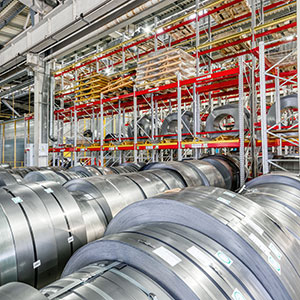 ANSI is closely aligned with the Rack Manufacturers Institute (RMI) and guidelines developed through ANSI are regularly cited by OSHA. Standards that relate specifically to pallet racking include:
ANSI is closely aligned with the Rack Manufacturers Institute (RMI) and guidelines developed through ANSI are regularly cited by OSHA. Standards that relate specifically to pallet racking include:
- MH16.1: Design, Testing, And Utilization Of Industrial Steel Storage Racks. Centered around the minimum requirements for the structural design and testing for steel racks, this standard applies to many of the structures most commonly found in modern warehouses: rack types such as push-back, case-flow, and pick modules.
- MH16.3: Design, Testing And Utilization Of Industrial Steel Cantilevered Storage Racks. Hard-to-shelve items often benefit from cantilever-oriented storage systems. These free up floor space and accommodate higher capacity requirements but they do present unique safety concerns. These are addressed in detail within this standard, which also delves into accessories such as canopies and decked shelves.
- MH26.2: Design, Testing And Utilization Of Welded Wire Rack Decking. Wire decking makes pallet racking systems more versatile and can also add much-needed support. This standard reveals which materials and dimensions can be used when working with wire decking while also verifying how decking should be fabricated and tested.
OSHA Regulations
The Occupational Safety and Health Administration (OSHA) plays a crucial role in promoting safety for pallet racks and warehouses in general. Requirements related to mechanical handling equipment include:
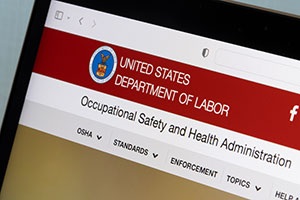 1926.250: General Requirements for Storage. Although it's not all that specific, this standard provides a basic overview for how stored materials should be handled. In general, they "should not create a hazard." Beyond this, items stored in tiers must be "stacked, blocked, interlocked and limited in height" to ensure that they are stable enough to avoid collapse.
1926.250: General Requirements for Storage. Although it's not all that specific, this standard provides a basic overview for how stored materials should be handled. In general, they "should not create a hazard." Beyond this, items stored in tiers must be "stacked, blocked, interlocked and limited in height" to ensure that they are stable enough to avoid collapse.- Occupational Safety and Health Act General Duty Clause. Insight from this clause may seem broad, but it's worth noting nonetheless: there is a strong need to provide a "place of employment...free from recognized hazards that are causing or are likely to cause death or serious physical harm" to employees.
Beyond this, OSHA draws heavily on guidelines developed by RMI under ANSI guidance. Organizations that comply with RMI guidelines can expect to also be in full compliance with OSHA regulations.
How to Comply with Racking Safety Requirements
There are many reasons to adhere closely to safety mandates from the RMI and OSHA. Chief among these? Employees deserve to work in a safe environment, which they should be able to navigate without fear of crumbling pallet racks, falling products, and other hazards.
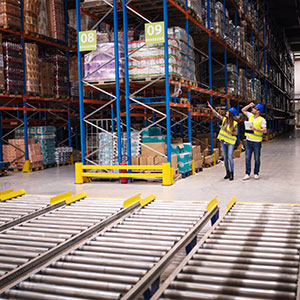 Labor concerns must also be taken into account. Should a workplace with chronic issues gain a reputation for being unsafe, finding and retaining quality employees will prove more difficult. Conversely, strong efforts to remain compliant will let employees know that they are valued.
Labor concerns must also be taken into account. Should a workplace with chronic issues gain a reputation for being unsafe, finding and retaining quality employees will prove more difficult. Conversely, strong efforts to remain compliant will let employees know that they are valued.
Beyond these employee concerns, there is also the regulatory landscape to keep in mind; the cost of noncompliance can be steep, even if employees manage to remain safe.
Significant monetary penalties can be assessed if OSHA violations are uncovered. These can be especially costly in severe cases, which are defined as violations that result in death or serious physical harm to the victim.
Should you realize that your pallet racking system is noncompliant or otherwise unsafe, you will want to take swift action to keep your employees safe. This is not the time to DIY your solution, as the inherent complications of pallet racking could cause you to repeat previous mistakes.
Instead, begin by consulting with pallet racking experts. This should be followed by an in-depth redesign and reconfiguration process. Experts can help you determine not only how to improve safety around the warehouse but also how to boost efficiency and capacity while implementing creative pallet storage techniques.
Common Mistakes to Avoid
Businesses that fail to fully adhere to safety regulations often make significant mistakes that leave employees at risk. Often, these issues occur because businesses are so focused on boosting efficiency or utilizing limited space that they make shortsighted errors. The following are among the most common concerns:
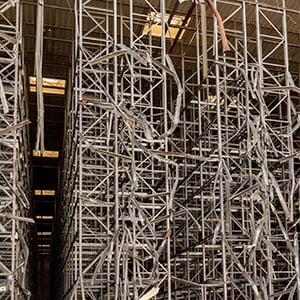 Using incorrectly sized racks. Pallet rack sizing can be surprisingly complicated. A lot depends on the size of the pallets themselves and the types of products being stored. The 48x40 GMA pallet is the most common but bulky items may call for unique layouts. Either way, sizing assessments are critical, both from a practical perspective and due to OSHA regulations. Optimal frame depth and height should be determined early on, along with potential accommodations for forklifts and other equipment.
Using incorrectly sized racks. Pallet rack sizing can be surprisingly complicated. A lot depends on the size of the pallets themselves and the types of products being stored. The 48x40 GMA pallet is the most common but bulky items may call for unique layouts. Either way, sizing assessments are critical, both from a practical perspective and due to OSHA regulations. Optimal frame depth and height should be determined early on, along with potential accommodations for forklifts and other equipment.- Overloading pallet racks. When space limitations come into play, it can be tempting to overload pallet racks to maximize capacity. This could be a dangerous mistake, however, as overloaded pallet racks are more likely to collapse. Even if they remain upright, there is a risk of stock falling. This could result in damaged products or even injured workers. Established weight limits should never be exceeded.
- Neglecting to anchor the racks. Pallet rack anchors are small, but critical. These plate-and-bolt systems are designed to secure pallet racks to the floor and can help them withstand a variety of forces. ANSI has approved strict RMI guidelines for how these racks should be anchored. Concrete flooring is a must for proper anchoring, which should also involve two footplate holes and a single anchor. Guidance will likely be needed to ensure that the correct anchor size is selected.
 Failure to maintain pallet racks. While strategic selection is important, it means little if pallet rack maintenance is neglected. Over time, even the sturdiest pallet racks will be vulnerable to wear and tear, especially if forklifts are present. Hence the need for regular maintenance, including in-depth inspections and testing to confirm component stability. When small signs of damage appear, they should be dealt with promptly before they spiral into big issues.
Failure to maintain pallet racks. While strategic selection is important, it means little if pallet rack maintenance is neglected. Over time, even the sturdiest pallet racks will be vulnerable to wear and tear, especially if forklifts are present. Hence the need for regular maintenance, including in-depth inspections and testing to confirm component stability. When small signs of damage appear, they should be dealt with promptly before they spiral into big issues.- Using damaged pallets and boxes. The quality of the pallets must be considered in addition to the condition of the racking systems. Holes and nails are a threat even when employees aren't climbing the racks. This is also an important component of safe pallet stacking.
- DIY fixes. Some operations address pallet damage promptly, but with the wrong components. DIY solutions are not advised; it's better to consult with and seek repair services from an expert, who can restore pallet racks to like-new condition.
- Neglecting expert input. With modern pallet racking, going it alone is definitely not advised. Today's systems are so advanced and so frequently include automated elements that it takes specialized expertise to understand how various components work together — and how the safest (and most efficient) system can be developed based on the unique needs of the business in question. Ordering without seeking input could prompt many of the issues highlighted above.
- Climbing the racks. Employees should never attempt to scale pallet racks. The racks are simply not designed for climbing. They lack handholds and may potentially be rife with hazards such as protruding nails. Employees need to be consistently reminded of the dangers of climbing through training and signage. Furthermore, rolling ladders should be made readily available so employees aren't tempted to climb.
Ensure Pallet Racking Safety with Warehouse1
Our team at Warehouse1 knows what it takes to balance common concerns such as safety and efficiency. We will help you find racking systems that optimize your space, keep your facility running smoothly, and most importantly, ensure that all workers remain safe at all times. Reach out today to learn more about our pallet racking products and our consultation services.
